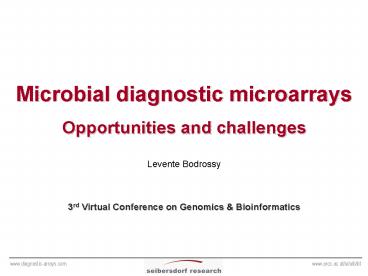Kein Folientitel - PowerPoint PPT Presentation
1 / 19
Title:
Kein Folientitel
Description:
Reliable detection and identification of one or a few microorganisms out of many ... Direct rRNA/tmRNA detectn, evanescent field scanning technology ... – PowerPoint PPT presentation
Number of Views:43
Avg rating:3.0/5.0
Title: Kein Folientitel
1
Microbial diagnostic microarrays
Opportunities and challenges
Levente Bodrossy
3rd Virtual Conference on Genomics
Bioinformatics
2
- Microbial diagnostic (identification, genotyping)
microarrays - Fast, parallel detection and identification of
microorganisms - Clinical and food applications
- Reliable detection and identification of one or a
few microorganisms out of many possible
3
- Microbial diagnostic (identification, genotyping)
microarrays - Fast, parallel detection and identification of
microorganisms - Clinical and food applications
- Reliable detection and identification of one or a
few microorganisms out of many possible - Environmental microbiology, microbial ecology
- Detection and identification of many
microorganisms in parallel analysis of microbial
community structures
Methodology Oligonucleotide microarrays
Molecular ecology .
4
Methodology
Sequence database establishment ARB software
package
5
Methodology
Sequence database establishment ARB software
package
Design of oligo probe set, in silico
predictions ARB, CalcOligo and Excel
Array printing aldehyde slides,
5-NH2-C12-TTTTT-18-28mer-3, 50 DMSO, contact
printing
6
(No Transcript)
7
Methodology
Sequence database establishment ARB software
package
Sampling lyophilisation
DNA purification bead beating
Design of oligo probe set, in silico
predictions ARB, CalcOligo and Excel
Preparation of labelled targets PCR with T7
modified primers In vitro transcription with
direct Cy3-UTP incorporation
Array printing aldehyde slides,
5-NH2-C12-TTTTT-18-28mer-3, 50 DMSO, contact
printing
Fragmentation Zn(II), alkalic pH
Hybridisation 5xSSC, O/N, 55C
2. those obtained with reference sequences
8
Methodology
Sequence database establishment ARB software
package
Sampling lyophilisation
DNA purification bead beating
Design of oligo probe set, in silico
predictions ARB, CalcOligo and Excel
Preparation of labelled targets PCR with T7
modified primers In vitro transcription with
direct Cy3-UTP incorporation
Array printing aldehyde slides,
5-NH2-C12-TTTTT-18-28mer-3, 50 DMSO, contact
printing
Fragmentation Zn(II), alkalic pH
Hybridisation 5xSSC, O/N, 55C
2. those obtained with reference sequences
9
Methodology
Sequence database establishment ARB software
package
Sampling lyophilisation
DNA purification bead beating
Design of oligo probe set, in silico
predictions ARB, CalcOligo and Excel
Preparation of labelled targets PCR with T7
modified primers In vitro transcription with
direct Cy3-UTP incorporation
Array printing aldehyde slides,
5-NH2-C12-TTTTT-18-28mer-3, 50 DMSO, contact
printing
Fragmentation Zn(II), alkalic pH
Details www.diagnostic-arrays.com /approach.htm
Hybridisation 5xSSC, O/N, 55C
Detection / identification of microorganisms Clin
ical/food applications
2. those obtained with reference sequences
10
Pilot chip - methanotrophs Application in
landfill site studies
11
Pilot chip - methanotrophs Application in
landfill site studies
12
Pilot chip - methanotrophs Application in
landfill site studies
13
Pilot chip - methanotrophs Application in
landfill site studies
- Type Ib and Type II dominating
- Type II (Methylocystis) only if methane added
- Type Ib (Methylocaldum) - stable presence
- Type Ia (Methylobacter) - in a few pots only
- Sporadic appearance of Methylomonas,
Methylomicrobum, group LP21 and
Methylocaldum-related groups
- Methylococcus, Methylosinus never detected
- (Ammonia oxidisers not targeted by PCR)
14
Application in landfill site studies strange
results (outlier pot)
15
Application in landfill site studies strange
results (outlier pot)
16
Application in landfill site studies strange
results (outlier pot)
Explanation air leaked into pot P20 ( gt very
high diversity)
Microbial community profiles pointing at
... Major differences in the analysed
environments/samples ? Environmental toxicology
human intestinal flora etc.
17
Pilot array - present potential
- Aim Community analysis of a well defined
physiological group of bacteria - Criteria Parallel, high-throughput, high
resolution, results comparable on a quantitative
basis - Up to 1000 oligoprobes applicable - parallel
- Results in 24 hours (starting from samples)
- Resolution down to the species level
- Analysis focused on a physiological group of
microbes - Analysis extended to uncultivated members of this
physiological group - PCR bias known manageable
- Reliable detection of major populations (bacteria
at 5 or more of the total community targeted by
the PCR) - Semi-quantitative results
- Quantitative comparisons, esp. for temporal or
spatial changes, possible - Generation of high resolution data on community
structures
18
Potential challenges and options to meet them
- Higher resolution needed (below the species
level, e.g. medical diagnostics)
- IGS, gyrB and tmRNA databases
- Array not focusable to a physiological group
- 16S, 23S (also gyrB and rpoB) databases
- PCR not acceptable (too much bias and/or only
live bacteria assayed for)
- Direct detection of rRNA or tmRNA
- More reliable quantification required
- 2-colour hybridisations
- Minor groups of bacteria (species, strains) need
to be reliably detected
- Sequence specific end labelling of
oligonucleotides
- Shorter time-to-result required (food
diagnostics, bedside diagnostics)
- Direct rRNA/tmRNA detectn, evanescent field
scanning technology
- Various limitations in probe design to be overcome
- LNA residues in DNA oligoprobes
- Other physiological group of bacteria to be
targeted
- Databases of other genes (e.g. nirS/nirK, nifH,
norB, mcrA, rbcL, ndoB, etc.)
- Physiological activities of the bacteria detected
to be understood
- Isotope arrays
19
Thanks to
- Seibersdorf, Austria
- Nancy Stralis-Pavese
- Angela Sessitsch
- Alexandra Weilharter
- Thomas Reichenauer
- Johann Riesing
- Warwick, UK
- J. Colin Murrell
- Stefan Radajewski
- Ian McDonald
- Szeged, Hungary
- József Csontos
- Sándor Bottka
- Marburg, Germany
- Peter Dunfield































